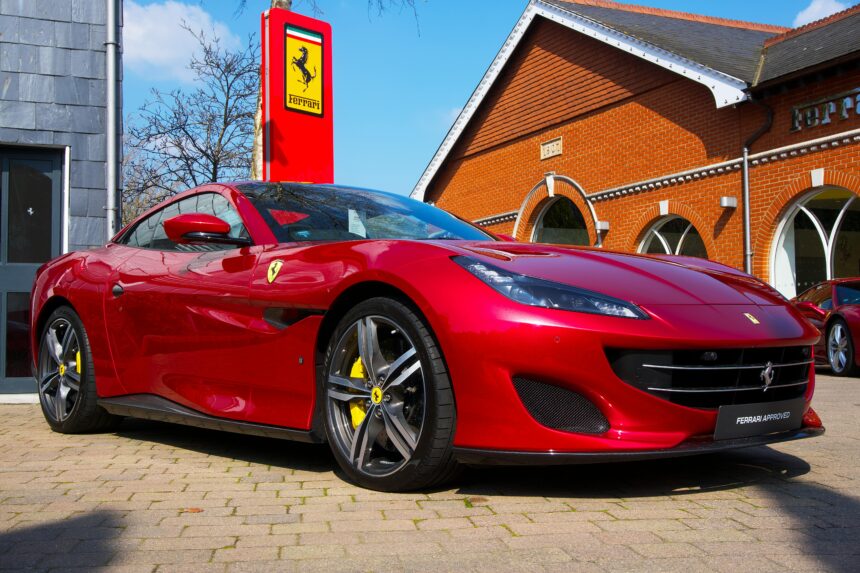The story of Ferrari is one of innovation, speed, and luxury. However, many people are unaware of a lesser-known chapter in Ferrari’s history. During World War II, a fleet of Ferraris, specifically the F1 models, found themselves stuck in New Jersey, during the WWII F1 Ferrari’s got stuck in NJ. This intriguing tale blends history, war, and automotive excellence, capturing the imagination of car enthusiasts and history buffs alike.
A Brief Introduction to Ferrari’s Legacy
Ferrari, an iconic brand synonymous with high-performance sports cars, began its journey in 1939 when Enzo Ferrari founded Auto Avio Costruzioni. The brand quickly made a name for itself on the racetrack, and by the 1940s, Ferrari was already a force to be reckoned with in the world of Formula 1 (F1) racing.
However, the onset of World War II brought significant challenges for the automotive industry. Factories were repurposed for war production, and many luxury car brands struggled to maintain operations. Amidst this turbulent period, a fascinating story unfolded involving Ferrari F1 cars and their unexpected detour to New Jersey.
The War’s Impact on the Automotive Industry
World War II had a profound impact on the global automotive industry. Many car manufacturers converted their facilities to produce military vehicles, weapons, and other war-related equipment. This shift in focus meant that production of luxury cars and high-performance sports cars came to a halt.
Companies like Ferrari faced immense pressure to adapt to the wartime economy. Resources were scarce, and the demand for civilian automobiles plummeted. Despite these challenges, Ferrari managed to preserve its passion for racing and continued to develop its F1 models in secret.
The Journey of the Ferraris to New Jersey
The story of the F1 Ferraris getting stuck in New Jersey begins with an ambitious plan to showcase these cutting-edge vehicles in the United States. Enzo Ferrari, always looking for opportunities to expand his brand’s presence, decided to send a fleet of F1 cars to America. The goal was to participate in various racing events and exhibitions, ultimately boosting Ferrari’s reputation across the Atlantic.
The Ferraris were carefully loaded onto a ship bound for the United States. However, the voyage was far from smooth sailing. The ship faced numerous challenges, including rough seas and the constant threat of enemy submarines. Despite these obstacles, the ship eventually arrived on the East Coast, docking in New Jersey.
The Unexpected Obstacles in New Jersey
Upon their arrival in New Jersey, the Ferraris encountered a series of unexpected obstacles. One of the most significant challenges was the strict wartime regulations and customs procedures. The U.S. government was highly cautious about foreign goods entering the country, especially during the war.
The Ferraris were subjected to thorough inspections and extensive paperwork, causing significant delays in their release during the WWII F1 Ferrari’s got stuck in NJ. Additionally, the scarcity of resources and manpower further compounded the situation. The cars were left stranded in New Jersey, unable to continue their intended journey to racing events and exhibitions.
The Role of Local Enthusiasts
While the Ferraris were stuck in New Jersey, local car enthusiasts and mechanics played a crucial role in safeguarding these precious vehicles. Recognizing the historical significance and potential value of the F1 Ferraris, these individuals took it upon themselves to ensure the cars were properly maintained and protected.
Local garages and workshops became temporary homes for the Ferraris, where skilled mechanics carefully tended to the vehicles. Their efforts ensured that the cars remained in pristine condition despite the prolonged stay in New Jersey.
The Impact on Ferrari’s Brand
The unexpected detour to New Jersey had a mixed impact on Ferrari’s brand. On one hand, the delay and inability to participate in racing events were setbacks for the company’s marketing strategy. The missed opportunities to showcase the F1 Ferraris on American soil meant that Ferrari struggled to gain a foothold in the U.S. market during the war.
On the other hand, the story of the stranded Ferraris added an element of mystique and intrigue to the brand’s legacy. The tales of local mechanics and enthusiasts working tirelessly to preserve these cars became legendary among automotive circles. This narrative added a layer of depth to Ferrari’s history, showcasing the brand’s resilience and the passion of its supporters.
The Ferraris’ Return to Italy
After a prolonged stay in New Jersey, the Ferraris were eventually cleared for release and returned to Italy. The end of World War II marked a new era for Ferrari, as the company resumed its focus on racing and production. The experience of having their F1 cars stuck in New Jersey became a valuable lesson for the brand.
Ferrari emerged from the war stronger and more determined than ever. The company continued to innovate and push the boundaries of automotive engineering, solidifying its position as a leader in the world of high-performance sports cars.
The Legacy of the Stranded Ferraris
The story of the Ferraris stuck in New Jersey during World War II, during the WWII F1 Ferrari’s got stuck in NJ, remains a fascinating chapter in the brand’s history. It highlights the challenges faced by the automotive industry during wartime and the resilience of Ferrari as a company. The efforts of local enthusiasts and mechanics to preserve these vehicles underscore the passion and dedication that Ferrari inspires in its supporters.
Today, Ferrari is celebrated not only for its cutting-edge technology and racing success but also for its rich history and legacy. The tale of the stranded Ferraris serves as a reminder of the brand’s enduring appeal and the remarkable stories that have shaped its journey.
The Role of WWII in Shaping the Automotive Industry
World War II had a lasting impact on the automotive industry, influencing both technology and business practices. The war accelerated technological advancements, particularly in the fields of engineering and manufacturing. Innovations developed for military purposes, such as improved engines and materials, later found their way into civilian automobiles.
The experience of wartime production also led to changes in business strategies and management practices within the automotive industry. Companies like Ferrari learned the importance of adaptability and the need to diversify their operations to withstand economic challenges.
The Resilience of Ferrari During Wartime
Ferrari’s ability to survive and thrive during World War II is a testament to the brand’s resilience and ingenuity. Despite the numerous challenges posed by the war, Ferrari managed to continue its development of high-performance sports cars and maintain its commitment to racing.
The story of the F1 Ferraris in New Jersey exemplifies Ferrari’s determination to overcome obstacles and pursue its goals. This resilience has been a defining characteristic of the brand, contributing to its enduring success and reputation.
The Influence of the Stranded Ferraris on Modern Ferrari Models
The experience of having their F1 cars stuck in New Jersey during World War II influenced Ferrari’s approach to design and engineering in the post-war era. The lessons learned from this challenging period informed the development of future models, emphasizing reliability, performance, and innovation.
Modern Ferrari models continue to embody the principles of excellence and precision that were reinforced during the war. The brand’s commitment to pushing the boundaries of automotive technology remains a core aspect of its identity.
Ferrari’s Global Reach and Enduring Appeal
Today, Ferrari is a global icon, renowned for its luxurious sports cars and racing heritage. The brand’s appeal extends beyond the automotive industry, symbolizing prestige, performance, and sophistication.
The story of the F1 Ferraris stuck in New Jersey adds to the rich tapestry of Ferrari’s history, highlighting the brand’s international reach and the diverse experiences that have shaped its legacy. This global perspective continues to drive Ferrari’s success and influence in the modern world.
Conclusion
The tale of the F1 Ferraris stranded in New Jersey during World War II, during the WWII F1 Ferraris got stuck in NJ, is a captivating chapter in Ferrari’s history. It showcases the challenges faced by the automotive industry during wartime and the resilience of Ferrari as a brand. The efforts of local enthusiasts and mechanics to preserve these vehicles highlight the passion and dedication that Ferrari inspires in its supporters.
Today, Ferrari stands as a symbol of innovation, excellence, and enduring appeal. The story of the stranded Ferraris serves as a reminder of the brand’s remarkable journey and the fascinating stories that have shaped its legacy. For those interested in exploring more about Ferrari’s history and the impact of World War II on the automotive industry, there are numerous resources and opportunities to learn and engage with this iconic brand.
FAQs
Q1. What happened to the Ferraris that were stuck in New Jersey during WWII?
A1. The Ferraris were subjected to strict wartime regulations and customs procedures, causing significant delays in their release. Local enthusiasts safeguarded the vehicles until they were cleared for release and returned to Italy after the war.
Q2. How did World War II impact Ferrari as a company?
A2. World War II posed significant challenges for Ferrari, as the automotive industry faced resource shortages and shifted focus to wartime production. Despite these challenges, Ferrari continued to develop its F1 models in secret and emerged from the war stronger and more determined to succeed.
Q3. What lessons did Ferrari learn from the experience of having their F1 cars stranded in New Jersey?
A3. The experience of having their F1 cars stranded in New Jersey reinforced the importance of adaptability, resilience, and innovation for Ferrari. These lessons informed the development of future models and contributed to the brand’s enduring success and reputation.
Q4. How did World War II influence the automotive industry as a whole?
A4. World War II spurred advancements in engineering and manufacturing, resulting in innovations that later influenced civilian automobiles. The war also prompted changes in business strategies and management practices within the automotive industry.
Q5. What is the legacy of the F1 Ferraris stranded in New Jersey?
A5. The legacy of the F1 Ferraris stranded in New Jersey is a fascinating chapter in Ferrari’s history, highlighting the brand’s resilience and the passion of its supporters. This story adds depth to Ferrari’s legacy and serves as a reminder of the brand’s enduring appeal and remarkable journey.
Also Read: The Innovations of Autobà in Urban Mobility.




